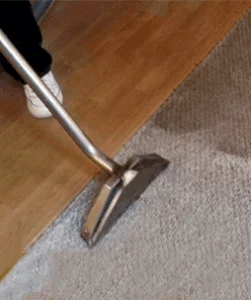 When installed correctly and taken care of, carpet is one of the most forgiving flooring options. And, it brings comfort and softness to your safe. Unfortunately, even carpet can have issues, like buckling and rippling. This happens when excess carpet material bunches up, causing all-too-familiar rolls of carpet that don’t lay flat. This can be a tripping hazard, in addition to being unsightly. We’re here to help you understand some of the causes of carpet rippling (to help you prevent them in the future) and what to do about carpet rippling you’re experiencing right now.
When installed correctly and taken care of, carpet is one of the most forgiving flooring options. And, it brings comfort and softness to your safe. Unfortunately, even carpet can have issues, like buckling and rippling. This happens when excess carpet material bunches up, causing all-too-familiar rolls of carpet that don’t lay flat. This can be a tripping hazard, in addition to being unsightly. We’re here to help you understand some of the causes of carpet rippling (to help you prevent them in the future) and what to do about carpet rippling you’re experiencing right now.
Carpet Repair/Stretching In Toms River
- Humidity. This is one of the biggest reasons that carpet can buckle. Humidity in the air can permeate the carpet and cause it to swell and spread slightly. It is common for buckling to happen in the summer months in humid areas. Moderately buckled carpet may lay flat again when the winter months roll around, but, running your AC or using a dehumidifier to get rid of some of the moisture in the area can help you avoid the problem altogether. Carpet that is badly buckled has likely creased, and may be ruined.
- Dragging heavy objects. Moving heavy objects by dragging them over the carpet can cause bunches in certain places. To avoid this stress to your carpet, lift and place your furniture and other objects when moving them, if possible.
- Delamination. Carpet that has undergone water damage (or is defective in some way) can delaminate, which means that the backing detaches from the visible carpet layer of your carpet, causing the top layer to freely bunch up. GM Carpet Care offer restoration for this problem for homes in the Toms River area.
- Improper installation. Sometimes, carpet just isn’t installed correctly. Carpet that isn’t stretched properly and taut when installed will relax. The excess material then bunches up and causes ripples and buckling. Luckily, you can still get a team out to stretch your carpet. Call GM Carpet Care for more information about this procedure, and a free quote.
- Incorrect under pad. Sometimes, the problem is as simple as the wrong materials being used. Under pads for carpet must be the proper density to be able to withstand the pressure they’ll be under routinely. If your carpet pad isn’t dense enough, the carpet can begin to ripple. In this case, a different under pad must be used in order to mitigate the problem.
If you are experiencing a carpet rippling or buckling issue in your Toms River home, be sure to call GM services to find out what is causing the problem and get a free assessment. In addition, we offer a range of carpet stretching, cleaning, and repair services that can restore your carpet to how it was (or how you’d like it to be) quickly and cost effectively. We encourage you to call us as soon as you decide your carpet needs help, because buckling and rippling problems are easier to solve if they’re relatively new, and the carpet hasn’t creased. Give our team a call today!
Why Do Carpets Buckle
Carpets may buckle for several reasons, including:
- Improper Installation: If the carpet was not installed correctly, it may buckle or wrinkle over time. This could be due to a failure to stretch the carpet tightly enough during installation or not using the proper tools and techniques.
- Humidity: Changes in humidity levels can cause carpet fibers to expand and contract, leading to ripples and buckles. High humidity levels can cause the carpet fibers to absorb moisture and expand, while low humidity levels can cause the carpet fibers to lose moisture and contract.
- Heavy Furniture: Heavy furniture that sits on the carpet for an extended period of time can cause dents and depressions in the carpet fibers. Over time, these can lead to buckling in the surrounding areas.
- Wear and Tear: Old or worn carpets can begin to buckle and ripple over time as the fibers become stretched, matted, or weakened.
- Subfloor Irregularities: A rough or uneven subfloor can cause the carpet to buckle or ripple over time. In some cases, a professional installer may need to correct the subfloor before the carpet can be properly installed.
Overall, proper installation and maintenance are key to preventing carpet buckling. Additionally, it is essential to address any humidity or subfloor issues before installing the carpet, as these can cause buckling even with proper installation and maintenance.
Additional Resources
- How Professionals Patch Carpet To Blend Perfectly
- What Is Professional Carpet Repair and How Does It Work?
- In this article, we explain How Commercial Carpet Cleaning Can Help Get You More Business.
- We provide Tips To Keep Carpets Clean In Your Rental Property in this article.
- Check out this article about How To Choose The Best Carpet Repair Services In Toms River!
